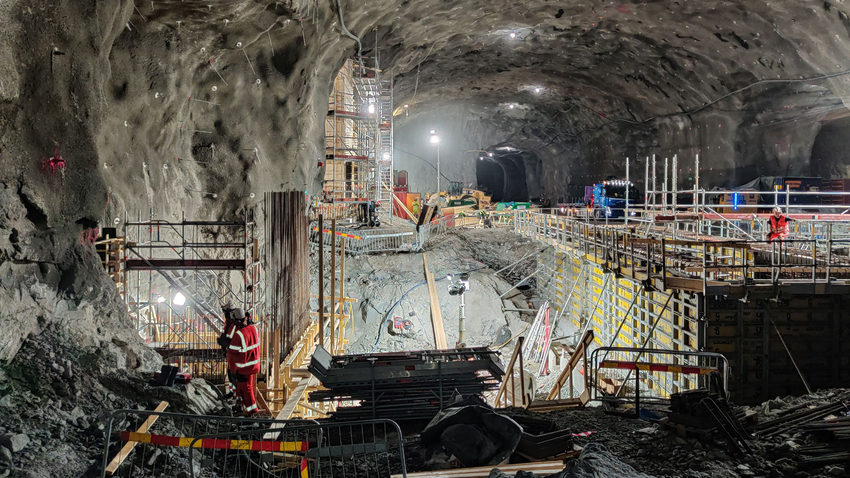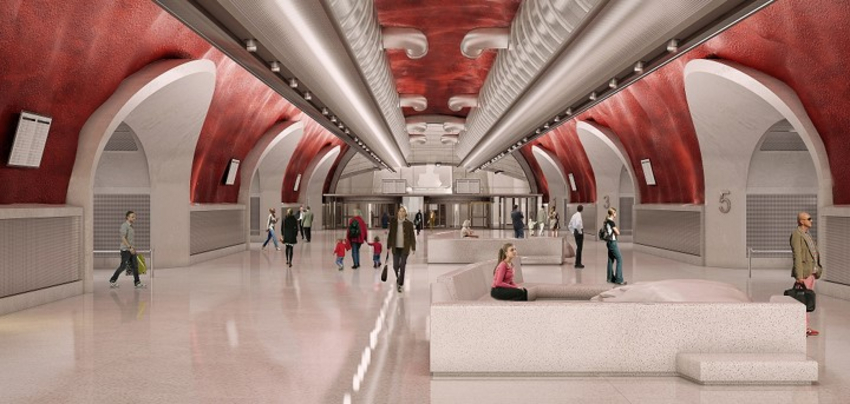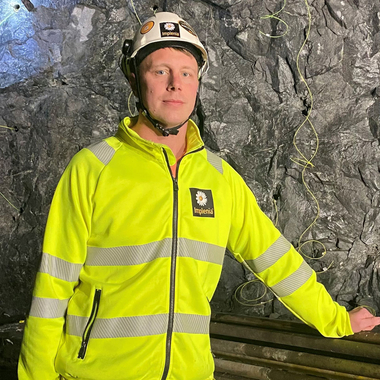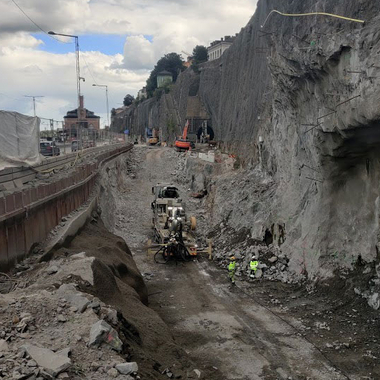Project Slussen SN91 successfully completed

Slussen is a lock and a historical landmark in the heart of Stockholm. Located between the Old Town and Södermalm, it connects Lake Mälaren with the Baltic Sea. It also gives its name to the adjacent transport hub, home to the Slussen metro station, the bus terminal, the starting point of the Saltsjöbanan railway and various road junctions.
The SN91 project is a small but integral part of the renovation of the entire area. The new bus station consists of three rock chambers with a height of up to 24 metres, which provide waiting areas for passengers and driving areas for buses. For their construction, we blasted and removed around 270,000 m3 of rock from inside the mountain. In addition to the extensive excavation work, we were also responsible for the construction of ramp tunnels, connecting tunnels and drainage tunnels. Planning work for the project began in 2017, construction in 2018, and we were able to complete our part of the construction work on time in May 2021. The interior work is scheduled for completion in 2023.

SN 91 SLUSSEN: Read the project description
The SN 91 Slussen project was demanding in many respects, and it is impressive how our team in Sweden managed to turn many of the challenges into success factors.
Blasting in densely populated areas
One of the biggest challenges was the location of the project: Slussen is right in the city centre, in close proximity to the existing bus station, the metro, ferry services, hotels, offices, churches and cultural institutions, where work and business life had to continue even during the blasting. "In order to keep the metro running throughout, even when we were excavating in close proximity, we spent a lot of time coordinating between all the parties involved," says Johan Pilbacka, Senior Project Engineer.
Another challenge was that the original plans were repeatedly adapted as the project progressed. Implenia took over a large part of the planning, actively sought the best solutions (economically and operationally) and in this way successfully drove the project forward. "There were challenges in terms of contracts, but in the end we were not only able to meet expectations, but even exceed them," explains Johan Pilbacka, not without pride.

Cooperation as a success factor
Perhaps the most important key factor in the success of the project was the exceptional quality of the collaboration, both internally at Implenia and with the client and all the other parties involved. Implenia's project organisation was the driving force from day one, ensuring that the various technical departments and people responsible for rock, soil, concrete and special works were able to work in parallel and in a coordinated manner. "It was like trying to put together a huge and extremely complex jigsaw puzzle," says Jan Eriksson, Country Head Safety.
“It was like trying to piece together a huge and extremely complex puzzle.”
Jan Eriksson, Country Head Safety
As everywhere else, the focus of the SN 91 project was on the best possible implementation of the project at the lowest possible cost. Our team was on the lookout for potential improvements and savings from day one.
Forward-looking logistics
Logistics provided an opportunity for this. The team organised areas near the project as temporary storage zones for material. This removed the need for frequent transport runs with smaller quantities, which made sense especially from an environmental point of view. And since we could buy materials in larger quantities and hold them ready for the next work steps, we also managed to reduce delivery times and thus avoid logistical problems on the construction site, which in turn had a positive effect on our costs.
The keys to success
- Competent and motivated project organisation
- Focus on improvements and cost savings
- Optimisation with regard to designs and use of materials
- Good cooperation within the project organisation
The highly complex Slussen SN91 project is an excellent example of what is possible when the entire organisation works together in a determined and coordinated way on a daily basis, actively living our values. As the following interviews with stakeholders show, working on SN91 was extremely challenging and educational - and fun. Our team all agree that they are proud to be involved in one of the coolest projects in Stockholm and to be part of something bigger: Implenia.
PROJECT SLUSSEN SN91 IN RETROSPECT: THE INTERVIEWS
How did our colleagues on the ground experience the project? Four of them describe their experiences:

Johan Pilbacka, Senior Project Engineer
"The metro had to keep running during the blasts."
SN91 was a complex project and required a lot of precision work. One of the biggest challenges was coordinating between all the parties involved so we could keep the underground in operation even when we were blasting in the immediate vicinity. We even had to blast our way into the metro platform to prepare an escalator.
We were involved in the planning from the beginning and also contributed to the technical solutions. The project was created in BIM, and with excellent results. There were challenges in terms of contracts, but we were able to meet all expectations. The key success factors were the cooperation and the fact that we all motivated each other every day. I am proud to have been part of the project from tender to completion.

Jan Eriksson, Country Head Safety, Implenia Sweden
"It was like putting together a huge and extremely complex jigsaw puzzle."
I wanted to be part of this great project because Slussen is a landmark that everyone in Sweden knows. In retrospect, I can say that SN91 was goldmine in terms of knowledge: you could learn about everything in this project, from BIM to complex construction issues. The fact that the project was also a commercial success is due to the good communication and the competent handling of unforeseen events. We also took great care to keep the documentation in order right from the start.
The biggest challenge in this project was the coordination. It was almost like trying to put together a huge and extremely complex jigsaw puzzle. During the project we had multiple work areas and disciplines scattered across all work areas. The key to success was the flexibility of everyone involved and their ability to adapt to ever-changing situations. It was also exciting how many specialists the project gathered in one place. One of our team happened to be "Rock Blaster of the Year 2020", but each and every person involved was very professional, understood his or her specific role in the project and worked together with everyone else towards the same goal. The absence of vanities and rivalries, which often occur in other projects, made it possible for us to complete this huge project so successfully.

Diana Safeen Butros, BIM Coordinator:
"I am happy about the successful introduction of digitalisation."
As BIM coordinator, I check and prepare the BIM models so that they can be used in production. A challenge for me in this project was the introduction of digitalisation. Teaching the construction team to use iPads instead of paper was great. I am genuinely happy when I enter the tunnel and see people standing over an iPad discussing things.
SN91 was the first project I worked on. The best memory for me is the first time I entered the tunnel: The scale and complexity of the project were simply overwhelming and that only really becomes visible on site. My main motivation and source of energy at work is my team. We have a corporate culture where we care for each other and find solutions together, even for difficult problems. I have found all this in the project and I am very proud to be a part of it.

Martin Dahl, Production Manager:
"Everything is oversized in this project - a real challenge!”
I have been on board with SN91 since May 2019. It is a very complex project. The biggest challenge is coordination and there is something new to do every day. What motivates me most about this project is that it has a wide variety of tasks. There are many different disciplines in our group, which means that no two days are the same.
One challenge is that there are incredibly large quantities of all the components and materials used, so everything is oversized. As my colleagues have already mentioned, coordination is one of the biggest challenges. I think we can all pat ourselves on the back and say: Well done! There was always a good atmosphere with happy faces on this project.


